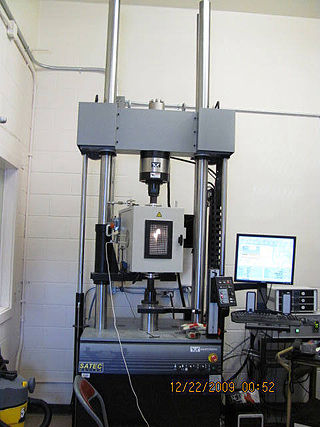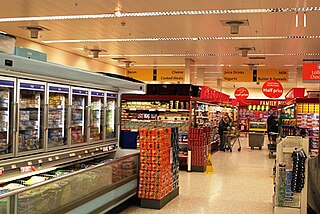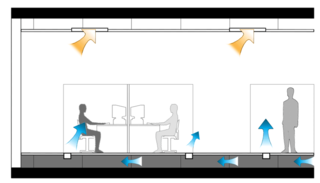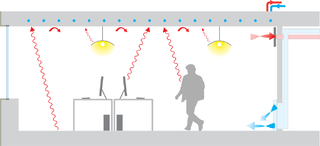Related Research Articles

Humidity is the concentration of water vapor present in the air. Water vapor, the gaseous state of water, is generally invisible to the human eye. Humidity indicates the likelihood for precipitation, dew, or fog to be present.

Heating, ventilation, and air conditioning (HVAC) is the use of various technologies to control the temperature, humidity, and purity of the air in an enclosed space. Its goal is to provide thermal comfort and acceptable indoor air quality. HVAC system design is a subdiscipline of mechanical engineering, based on the principles of thermodynamics, fluid mechanics, and heat transfer. "Refrigeration" is sometimes added to the field's abbreviation as HVAC&R or HVACR, or "ventilation" is dropped, as in HACR.

Ventilation is the intentional introduction of outdoor air into a space. Ventilation is mainly used to control indoor air quality by diluting and displacing indoor pollutants; it can also be used to control indoor temperature, humidity, and air motion to benefit thermal comfort, satisfaction with other aspects of the indoor environment, or other objectives.
Operative temperature is defined as a uniform temperature of an imaginary black enclosure in which an occupant would exchange the same amount of heat by radiation plus convection as in the actual nonuniform environment. Some references also use the terms 'equivalent temperature" or 'effective temperature' to describe combined effects of convective and radiant heat transfer. In design, operative temperature can be defined as the average of the mean radiant and ambient air temperatures, weighted by their respective heat transfer coefficients. The instrument used for assessing environmental thermal comfort in terms of operative temperature is called a eupatheoscope and was invented by A. F. Dufton in 1929. Mathematically, operative temperature can be shown as;

Building science is the science and technology-driven collection of knowledge in order to provide better indoor environmental quality (IEQ), energy-efficient built environments, and occupant comfort and satisfaction. Building physics, architectural science, and applied physics are terms used for the knowledge domain that overlaps with building science. In building science, the methods used in natural and hard sciences are widely applied, which may include controlled and quasi-experiments, randomized control, physical measurements, remote sensing, and simulations. On the other hand, methods from social and soft sciences, such as case study, interviews & focus group, observational method, surveys, and experience sampling, are also widely used in building science to understand occupant satisfaction, comfort, and experiences by acquiring qualitative data. One of the recent trends in building science is a combination of the two different methods. For instance, it is widely known that occupants’ thermal sensation and comfort may vary depending on their sex, age, emotion, experiences, etc. even in the same indoor environment. Despite the advancement in data extraction and collection technology in building science, objective measurements alone can hardly represent occupants' state of mind such as comfort and preference. Therefore, researchers are trying to measure both physical contexts and understand human responses to figure out complex interrelationships.
Displacement ventilation (DV) is a room air distribution strategy where conditioned outdoor air is supplied at a low velocity from air supply diffusers located near floor level and extracted above the occupied zone, usually at ceiling height.

Underfloor heating and cooling is a form of central heating and cooling that achieves indoor climate control for thermal comfort using hydronic or electrical heating elements embedded in a floor. Heating is achieved by conduction, radiation and convection. Use of underfloor heating dates back to the Neoglacial and Neolithic periods.
Thermal comfort is the condition of mind that expresses satisfaction with the thermal environment and is assessed by subjective evaluation. The human body can be viewed as a heat engine where food is the input energy. The human body will release excess heat into the environment, so the body can continue to operate. The heat transfer is proportional to temperature difference. In cold environments, the body loses more heat to the environment and in hot environments the body does not release enough heat. Both the hot and cold scenarios lead to discomfort. Maintaining this standard of thermal comfort for occupants of buildings or other enclosures is one of the important goals of HVAC design engineers.

Passive ventilation is the process of supplying air to and removing air from an indoor space without using mechanical systems. It refers to the flow of external air to an indoor space as a result of pressure differences arising from natural forces.
Air changes per hour, abbreviated ACPH or ACH, or air change rate is the number of times that the total air volume in a room or space is completely removed and replaced in an hour. If the air in the space is either uniform or perfectly mixed, air changes per hour is a measure of how many times the air within a defined space is replaced each hour. Perfectly mixed air refers to a theoretical condition where supply air is instantly and uniformly mixed with the air already present in a space, so that conditions such as age of air and concentration of pollutants are spatially uniform.

Thermal destratification is the process of mixing the internal air in a building to eliminate stratified layers and achieve temperature equalization throughout the building envelope.

Underfloor air distribution (UFAD) is an air distribution strategy for providing ventilation and space conditioning in buildings as part of the design of a HVAC system. UFAD systems use an underfloor supply plenum located between the structural concrete slab and a raised floor system to supply conditioned air to supply outlets, located at or near floor level within the occupied space. Air returns from the room at ceiling level or the maximum allowable height above the occupied zone.

A high-volume low-speed (HVLS) fan is a type of mechanical fan greater than 7 feet (2.1 m) in diameter. HVLS fans are generally ceiling fans although some are pole mounted. HVLS fans move slowly and distribute large amounts of air at low rotational speed– hence the name "high volume, low speed."
Clothing insulation is the thermal insulation provided by clothing.

Radiant heating and cooling is a category of HVAC technologies that exchange heat by both convection and radiation with the environments they are designed to heat or cool. There are many subcategories of radiant heating and cooling, including: "radiant ceiling panels", "embedded surface systems", "thermally active building systems", and infrared heaters. According to some definitions, a technology is only included in this category if radiation comprises more than 50% of its heat exchange with the environment; therefore technologies such as radiators and chilled beams are usually not considered radiant heating or cooling. Within this category, it is practical to distinguish between high temperature radiant heating, and radiant heating or cooling with more moderate source temperatures. This article mainly addresses radiant heating and cooling with moderate source temperatures, used to heat or cool indoor environments. Moderate temperature radiant heating and cooling is usually composed of relatively large surfaces that are internally heated or cooled using hydronic or electrical sources. For high temperature indoor or outdoor radiant heating, see: Infrared heater. For snow melt applications see: Snowmelt system.

The thermal manikin is a human model designed for scientific testing of thermal environments without the risk or inaccuracies inherent in human subject testing. Thermal manikins are primarily used in automotive, indoor environment, outdoor environment, military and clothing research. The first thermal manikins in the 1940s were developed by the US Army and consisted of one whole-body sampling zone. Modern-day manikins can have over 30 individually controlled zones. Each zone contains a heating element and temperature sensors within the “skin” of the manikin. This allows the control software to heat the manikin to a normal human body temperature, while logging the amount of power necessary to do so in each zone and the temperature of that zone.

IDA IndoorClimate andEnergy is a Building performance simulation (BPS) software. IDA ICE is a simulation application for the multi-zonal and dynamic study of indoor climate phenomena as well as energy use. The implemented models are state of the art, many studies show that simulation results and measured data compare well.

Ventilative cooling is the use of natural or mechanical ventilation to cool indoor spaces. The use of outside air reduces the cooling load and the energy consumption of these systems, while maintaining high quality indoor conditions; passive ventilative cooling may eliminate energy consumption. Ventilative cooling strategies are applied in a wide range of buildings and may even be critical to realize renovated or new high efficient buildings and zero-energy buildings (ZEBs). Ventilation is present in buildings mainly for air quality reasons. It can be used additionally to remove both excess heat gains, as well as increase the velocity of the air and thereby widen the thermal comfort range. Ventilative cooling is assessed by long-term evaluation indices. Ventilative cooling is dependent on the availability of appropriate external conditions and on the thermal physical characteristics of the building.
Occupant-centric building controls or Occupant-centric controls (OCC) is a control strategy for the indoor environment, that specifically focuses on meeting the current needs of building occupants while decreasing building energy consumption. OCC can be used to control lighting and appliances, but is most commonly used to control heating, ventilation, and air conditioning (HVAC). OCC use real-time data collected on indoor environmental conditions, occupant presence and occupant preferences as inputs to energy system control strategies. By responding to real-time inputs, OCC is able to flexibly provide the proper level of energy services, such as heating and cooling, when and where it is needed by occupants. Ensuring that building energy services are provided in the right quantity is intended to improve occupant comfort while providing these services only at the right time and in the right location is intended to reduce overall energy use.

Clothing physiology is a branch of science that studies the interaction between clothing and the human body, with a particular focus on how clothing affects the physiological and psychological responses of individuals to different environmental conditions. The goal of clothing physiology research is to develop a better understanding of how clothing can be designed to optimize comfort, performance, and protection for individuals in various settings, including outdoor recreation, occupational environments, and medical contexts.
References
- 1 2 3 4 5 6 7 8 9 10 11 12 13 14 15 16 17 18 19 20 21 22 23 24 25 26 27 28 29 30 31 32 33 34 35 36 37 38 39 40 41 42 43 44 ASHRAE Standard 55 (2013). "Thermal Environmental Conditions for Human Occupancy".
{{cite journal}}: Cite journal requires|journal=(help)CS1 maint: numeric names: authors list (link) - 1 2 Tartarini, Federico; Schiavon, Stefano; Cheung, Toby; Hoyt, Tyler (2020). "CBE Thermal Comfort Tool: Online tool for thermal comfort calculations and visualizations". SoftwareX. 12: 100563. Bibcode:2020SoftX..1200563T. doi: 10.1016/j.softx.2020.100563 . S2CID 225631918.
- ↑ Tartarini, Federico; Schiavon, Stefano (2020-07-01). "pythermalcomfort: A Python package for thermal comfort research". SoftwareX. 12: 100578. Bibcode:2020SoftX..1200578T. doi: 10.1016/j.softx.2020.100578 . ISSN 2352-7110.
- ↑ Fanger, P.O. (1970). Thermal Comfort. Copenhagen: Danish Technical Press.
- ↑ Nishi, Y; Gagge, A.P. (1977). "Effective temperature scale useful for hypo-and hyperbaric environments". Aviation, Space, and Environmental Medicine. 48 (2): 97–107. PMID 871288.
- ↑ "Addendum a to Standard 55-2013" (PDF). ASHRAE. Archived from the original (PDF) on 8 December 2014. Retrieved 5 December 2014.
- 1 2 ASHRAE Standard 55 (2004). "Thermal Environmental Conditions for Human Occupancy".
{{cite journal}}: Cite journal requires|journal=(help)CS1 maint: numeric names: authors list (link) - ↑ ASHRAE Standard 55 (1992). "Thermal Environmental Conditions for Human Occupancy".
{{cite journal}}: Cite journal requires|journal=(help)CS1 maint: numeric names: authors list (link) - ↑ ASHRAE Standard 55 (2010). "Thermal Environmental Conditions for Human Occupancy".
{{cite journal}}: Cite journal requires|journal=(help)CS1 maint: numeric names: authors list (link) - ↑ ASHRAE Standard 55 (2020) "Thermal Environmental Conditions for Human Occupancy" ashrae.org
- ↑ ASHRAE Standard 55 (2023) "Thermal Environmental Conditions for Human Occupancy" ashrae.org (read only preview)